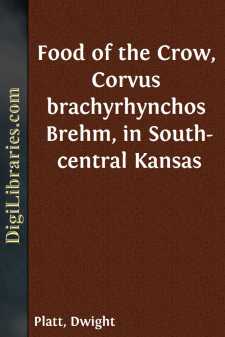Categories
- Antiques & Collectibles 13
- Architecture 36
- Art 48
- Bibles 22
- Biography & Autobiography 813
- Body, Mind & Spirit 142
- Business & Economics 28
- Children's Books 17
- Children's Fiction 14
- Computers 4
- Cooking 94
- Crafts & Hobbies 4
- Drama 346
- Education 46
- Family & Relationships 57
- Fiction 11829
- Games 19
- Gardening 17
- Health & Fitness 34
- History 1377
- House & Home 1
- Humor 147
- Juvenile Fiction 1873
- Juvenile Nonfiction 202
- Language Arts & Disciplines 88
- Law 16
- Literary Collections 686
- Literary Criticism 179
- Mathematics 13
- Medical 41
- Music 40
- Nature 179
- Non-Classifiable 1768
- Performing Arts 7
- Periodicals 1453
- Philosophy 64
- Photography 2
- Poetry 896
- Political Science 203
- Psychology 42
- Reference 154
- Religion 513
- Science 126
- Self-Help 84
- Social Science 81
- Sports & Recreation 34
- Study Aids 3
- Technology & Engineering 59
- Transportation 23
- Travel 463
- True Crime 29
Food of the Crow, Corvus brachyrhynchos Brehm, in South-central Kansas
by: Dwight Platt
Description:
Excerpt
Introduction
The yearly diet of the crow was studied from December, 1952, to February, 1954, in Harvey County and the northeastern townships of Reno County, in south-central Kansas. In the United States much attention has been devoted previously to the food taken by the crow because it is of economic importance. The work of Barrows and Schwarz (1895) was the first of a series of studies made by the United States Department of Agriculture. Kalmbach (1918, 1920, 1939) continued these studies by analyzing stomach contents from various parts of the United States. Also he diet of the crow has been studied by local areas (Imler—Oklahoma, 1939; Hering—New York, 1934; Black—Illinois, 1941; Lemaire—Louisiana, 1950).
I am grateful to Dr. Henry S. Fitch, for many valuable suggestions and helpful encouragement given in the course of my study. Professor E. Raymond Hall, who read the manuscript, likewise offered valuable suggestions. Dr. R. L. McGregor and Mr. Wilford Hanson provided invaluable assistance in identification of plants and insects found in the crow pellets.
Methods
Previous studies were based mostly on analyses of stomach contents. My study is based on the analysis of 617 regurgitated pellets collected from roosts and lookout posts. Fifty-three collections of pellets were made throughout the year at regular intervals, except that none was made in January, March, or May. The pellets were wrapped individually in paper or leaves as collected, and each was analyzed separately. The percentages by bulk of different food residues (excluding sand and other extraneous material) were estimated in each pellet and recorded.
The study area is on the eastern edge of the Great Bend Prairie physiographic province of Moore (1930). The climate is characterized by moderate precipitation (ann. 30"), a wide range of temperature variations, moderately high wind velocities, and comparatively rapid evaporation. The summers are generally hot, and the winters are moderately cold but are free from excessive snowfall. The weather during the study period was unusually dry, and the summer temperatures were above normal. A drought had begun in 1952, following the cool and wet summer of 1951.
The study area includes the zone of transition from bluestem or tall-grass prairie to the buffalo grass or short-grass prairie. The principal farm crop in the study area is wheat. Sorghum grain, oats, hay crops (especially alfalfa), and corn are also grown. The study area supported a small population of breeding crows; an estimate based on field observations mainly in eastern Harvey County, was not more than one pair per square mile. In winter a large population of crows migrates into the area from the northern Great Plains. Censuses showed that on parts of the area the feeding population might be as great as 180 birds per square mile. These wintering crows concentrate in the western part of the study area where the flat, fertile wheat fields of central Harvey County are replaced by sand dunes and the sandy Arkansas River Valley....


